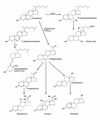Cholesterol in health and disease
- PMID: 12208856
- PMCID: PMC151113
- DOI: 10.1172/JCI16381
Cholesterol in health and disease
Figures





References
-
- Bloch KE. Speculations on the evolution of sterol structure and function. CRC Crit Rev Biochem. 1979;7:1–5. - PubMed
-
- Cavalier-Smith T. The neomuran origin of archaebacteria, the negibacterial root of the universal tree and bacterial megaclassification. Int J Syst Evol Microbiol. 2002;52:7–76. - PubMed
-
- Ranadive GN, Lala AK. Sterol-phospholipid interaction in model membranes: role of C5-C6 double bond in cholesterol. Biochemistry. 1987;26:2426–2431. - PubMed
-
- Haines TH. Do sterols reduce proton and sodium leaks through lipid bilayers? Prog Lipid Res. 2001;40:299–324. - PubMed
-
- Esfahani M, Scerbo L, Devlin TM. A requirement for cholesterol and its structural features for a human macrophage-like cell line. J Cell Biochem. 1984;25:87–97. - PubMed
Publication types
MeSH terms
Substances
LinkOut - more resources
Full Text Sources
Other Literature Sources
Medical

